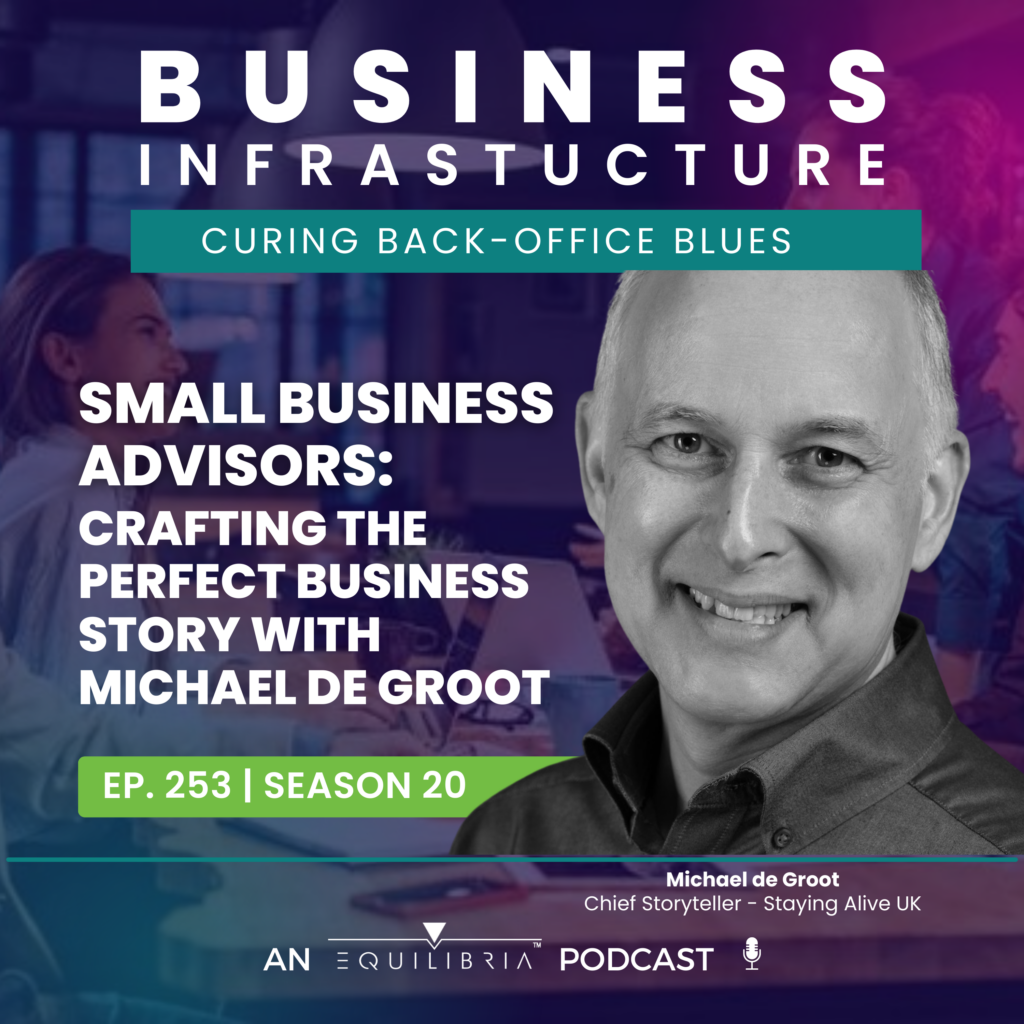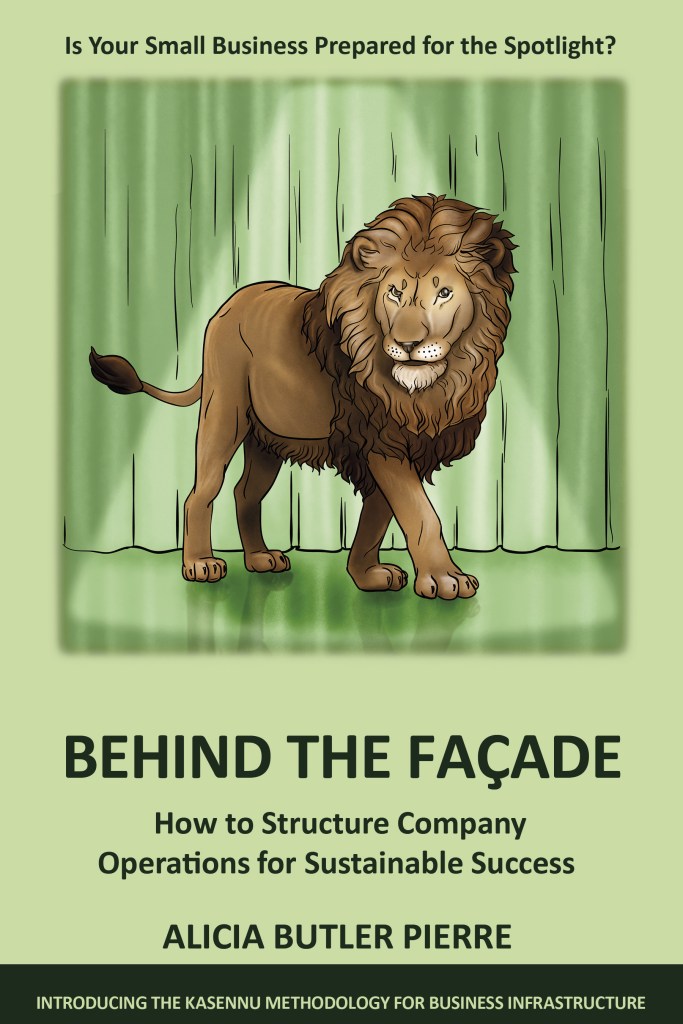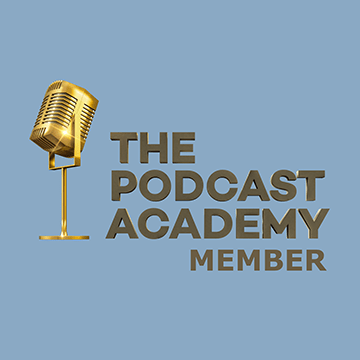Transcript
This episode is underwritten by Equilibria, Inc. the company behind this podcast where we design scale-ready business infrastructure for fast-growing small businesses.

Stories have a way of helping us to connect with each other. They have the power to evoke emotions and even prompt us to take action, whether good or bad, right or wrong. So, imagine what would happen if you told a powerful story about your business that drew people in like moths to a flame. It’s totally possible, but the real question is…are you ready for that kind of success?
It’s Season 20 of the Business Infrastructure podcast – the show where we share operational tips, strategies, and tactics to help you cure any back-office blues you might be experiencing. This season features 12 small business advisors, each with a unique skillset they’ll share with you.
Have you ever struggled to attract potential customers to your product or service that you’re sure is valuable and has the potential to solve their problems? Storytelling is a way to get their attention, keep it, and convert them into paid customers. And our featured small business advisor is about to tell you exactly how to do that.
This is Episode 253 – Crafting the Perfect Business Story with Michael de Groot
My name is Michael de Groot. It’s Dutch. It means, literally translated, The Great. I am in the UK and I, work for my own company called Staying Alive UK. And I call myself Chief Storyteller. Thank you so much for having me, Alicia.
As a Dutchman living in the UK, Michael has quite the story himself…starting with his upbringing.
I was born in Amsterdam and my father was Dutch and my mother was actually Anglo-Indian. that’s always what she used to call herself. They met in London many, many moons ago. And yeah, the rest is history.
Michael was around 13 years old when his family relocated from the Netherlands. And here’s where his backstory really starts to take shape – his family relocated across the Atlantic Ocean to a small country in South America called Suriname. It was an experience that would leave an indelible mark on his life.
We lived there for three years and it was such an experience. I’d never seen poverty before, and it just blew my mind being in a tropical country. Wonderful experience. We came back to The Netherlands. Now remember I said my mother was Anglo-Indian, so she was born in India, but her forefathers were from Ireland.
And she had a very English upbringing. and my father was told, right, you have a choice. You can either go to London (where it rains most of the time), or you can go to the US Virgin Islands, Alicia, that was the choice. And he gave that choice to my mother to make. And she chose London, of course, where she always wanted to go. And I have been to the US Virgin Islands, so rest her soul, I’ve never forgiven her.
Hmm…the U.S. Virgin Islands and its tropical paradise vs. London and its infamous fog. I don’t blame Michael for being upset over his mother’s decision. Of course, he’s kidding about not forgiving her. He and his twin sister did eventually adjust to being in London. And it’s there where he would stumble into his first career in textiles.

Well, when we came to the UK, I was kind of halfway through education and we had to interrupt that, and we interrupted it by stopping a particular school year and then waiting to be posted out to the UK. So instead, my sister and I went to work for an uncle, well, he was our best friend in the family, but we called him uncle.
So we were working and earning a bit of pocket money, doing work in the warehouse. My sister was doing administration work. And when that was finished, we now had the taste of money and we went, “Oh, we earned some money!” So, when we came to the UK, my parents said, “You need to go back and do some more studying.” And we went, “We don’t wanna do any studying in English,” which wasn’t really our first language.
“And therefore that will be really tough. We don’t want to do that.” So, we moved on to wanting to do a job. Parents agreed. And we looked at London, we lived outside of London in a county called Surry. And we both looked for jobs where we could use our Dutch language. So, our founder’s job was for an American textile company called Burlington Industries. I got a job there liaising with the Belgian sales office, where they speak Dutch as well. So, I could speak Dutch and in the office, I could speak English. So that’s how my journey in work textile started.
That journey in the textile industry lasted 28 years until, one day, Michael decided to move on to something else.
Alicia, I always wanted to get out of it, but I had no university qualifications. I didn’t feel like I had anything to offer. I did great in the textile industry, I kept being promoted from job to job. I was super talented for some reason, and eventually, you know, ended up on boards of companies as a director. The textile industry is such hard work. I had wonderful experiences, but also remember just working so hard.
All of Michael’s hard work was taking a physical toll on him. Never could he have imagined that a chance conversation on a flight to New York would open the doors to entrepreneurship.

I was traveling with our head designer. I was the sales and marketing director. And we were going to visit New York, Victoria’s Secret to show our product, to show our fabrics. And on the journey, I was complaining about headaches. my sister suffers from something called Crohn’s Disease. I’m her twin, so I thought I was having the same issue. She then went, turned around, and said, “Oh, when we get to New York, I will give you some reiki and why don’t you go and visit this lady in Lester,” a town in the UK, “and have some kinesiology.”
And I went, “Stop, stop!” “You’re just talking Chinese to me right now. I have no idea what you’re talking about.”
But it wouldn’t be long before Michael decoded and discovered exactly what this designer was talking about.
I was way ahead of anybody talking about health and wellness at work, in the UK anyway. It was just the beginning of it. And, I was too early, Alicia, the recession started in 2007, 08. I literally had a dream, about what I was gonna call my business.
And I woke up and the message was, Staying Alive UK. And I went, “Well, Staying Alive is a BeeGee song, right?” One of the most famous songs in the world, which I happen to love. And I went, “That’s brilliant!” I can definitely use Staying Alive. I can play the song. And I did. When I did presentations, I played the song and I got the whole audience to sing it.
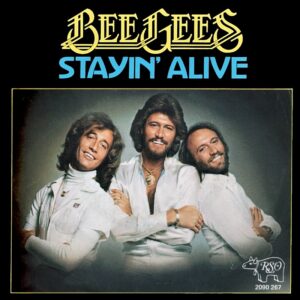
And so the name kind of stuck, although there was a recession that happened, we all know what happened. Lehman Brothers folded in 2008 on my birthday – on the 15th of September. I had a contract pending with a really large company, and they just canceled on me. So, I had to go and look and do something else. And that’s how my new direction was born.
I can’t even connect the dots on this journey. Whilst I was looking for work, I was self-employed on my own, not earning, and needing to pay a mortgage my sister introduced me to a company that did online learning, but they had no video. They just had typed text on screens for management training. And they said they’re looking for some people to help freelance. So, I freelanced for this company for a couple of years, but I didn’t really get on with it that well. I got them in some really good business. Then I got headhunted to do more freelance for a company that did the same management training online learning for organizations.
But this time they used video. And I went, “That’s it! It has to be video.” I then came across a company, called RSA – Royal Society of Arts Animate. And they did animations where you see the hand drawing on the screen, and they were reading a lecture in the background. So it was audio, but the audio and what they were talking about was being displayed on this screen. And I went, “Wow! I want to know how to do this.”
And in fact, the previous company, I had presented this to them and then we learned it was really expensive and a waiting list for like six months. And I planted that seed in my head that I wanted to get involved in that area. And the video learning company showed me some tricks, how to create a video using PowerPoint, slide in some images, put a voice-over, you know, create a little image.
And I started doing this and I got some business. And this is then how the journey of storytelling started because people gave me the information about what their advert was. And I started thinking, Oh, these are really bad. You know, this is not a good message they’re sending out to their clients. There must be a better way.
So I started to train myself in the art of storytelling and what it takes to create a good story and, a short story, that goes with a video clip. So put those two things together. I then came across a piece of software that allowed me, to create these animations myself. It’s not easy to do, but I mastered the skill and coupled with my storytelling script-writing skills, advised the customer that, okay, give me the basic bones of it and I will create a story out of it.
And just like that, Michael had repurposed and rebranded Staying Alive UK from a wellness company to a storytelling and video production company.
Some people then told me later on, they said, “You should run courses on storytelling cuz you seem to know what you’re talking about.” I went, “Nah, there’s probably better people.” So just before Covid struck, I did start to deliver to small business owners, and young people as well, who were just starting out how to develop their own storytelling skills.
So I have a structure to walk people through. It’s not very difficult, Alicia, because we are all storytellers already. we were trained when we were from like two years old because our parents
were telling us stories every single night if we were lucky. Our brain was being rehearsed for that. We talk in stories, when we have conversations with our friends, our family, and our colleagues, they are all stories. So, it isn’t difficult, but there is a format and there is a bit of a structure, but once you master that, you’ll just get it because you’re already a natural storyteller.

So, we’re all natural storytellers, huh? Well, when we come back after this commercial break we’re going to put that to the test. Michael will walk us through his storytelling process as we use the case study of a young entrepreneur with a henna tattoo business. That and more coming up after the break.
How do you know if your business is growing faster than you can keep up with? If you have trouble keeping up with things like deliveries and projects. Your customers are angry, team turnover is high, and the complaints are piling up. Where can you go for relief? How can you save your business from the chaos of unmanageable, fast growth?
It might be time to build business infrastructure. Business infrastructure is a system for linking the people, processes, tools, and technologies that act as the heartbeat of your back-office operations. It gives your fast-growing small business a stable foundation to not only continue growing but to scale in a profitable, sustainable, and repeatable way.
That’s why if you want a business that can consistently operate without your daily presence, then the Smooth Operator course is for you. It’s an online introductory course on business infrastructure that can provide you with proven tools, tactics, and techniques to calm the chaos and restore order. Go to SmoothOperator.courses to learn more. That’s SmoothOperator.courses.
We’re back and before the break, Michael de Groot, Chief Storyteller at Staying Alive UK, mentioned that we’re all natural storytellers. And if you don’t believe him, then listen up as he describes his 13-step process for helping you tell your business story. We’ll initially use a young entrepreneur that I recently met as a case study. I’m going to start by reading about his process directly from his company’s website. Here’s Michael.
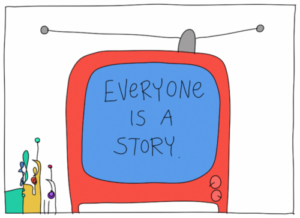
Okay.
It says, “The journey is relatively simple, although if you are not used to storytelling, you’ll need to reeducate your thinking away from traditional product advertising. If you’re stuck, just ask me.” So, step one is Wangle an interesting story out of you. This young lady, 16 years old, told me about her idea for a henna tattooing business. How would you walk her through your process?
So, the first question I would ask her is, who is your client? Who are the people that you are working with? And I’m assuming she probably has had some clients already, even if it’s family members to practice on, right? Cuz if she’s studying how to do this and learning her craft, she needs some people that will want it. And I would like her then to go into the mind of those clients.
And if she doesn’t know their mind, then she can ask them some questions about why are having this henna tattoo. How does it make you feel after you’ve had it? Or how do you feel before you’ve had it? So what is it that changes when you have that tattoo? How does it make you feel?
Where will you see, or hear that people are going to be observing the tattoo? For example, they might be saying, “Wow, I love your tattoo!” Or, you know, she can see people smiling and, you know, giving her high fives. Now the reason I’m focusing so much on the individuals is cuz when we feel something it creates an emotion in our brain. And when we create an emotion in our brain, our memory, of that event will last with us much, much longer.

All of us can remember events in our lives that created an emotion, either a happy or a sad emotion. You only need to listen to a piece of music sometimes, or you know, an event that happened at school, where you can immediately go back to that situation. So, get the story about the individual, first of all. And once you know about the individual, you can write a story about that person without mentioning any names.
You can go, “This person came to me because it made her feel this way.” That’s the selling point. But to get up to that point, you need to find out what some of the pain points are for that individual, for that character. That’s why I said how were they feeling before they had it. Why are they gonna spend money on it?
Only because they want to change their state, their emotion, the way they’re feeling about themselves, and the way they want to be perceived in the world even. So, let’s go behind that person’s
emotions. And you don’t have to have a unique description of that. You need to have a general one, but you need to base it on some truth. So, I don’t want to be totally fictitious. You need to do some research.
That covers the first step of Michael’s 13-step storytelling process. The next step involves him helping to refine your story’s script.
I generally will change the script to change the story to a better version of what they’ve written. Cuz not everybody will be able to write the best thing. with their permission. I will show them a better version. Then we go through splitting it into screens and then I literally have to go walk the dog and think about what are some of the images that I would like for each scene to go with that bit of the story.
In other words, Michael starts to envision a storyboard. This covers steps 3 through 6 of his storytelling process. In case you’re wondering, a storyboard is a visual depiction of a story in pictures.
We do the storyboard and present that back. We do some sketches to go for each scene. We send that back to the client. They have a look, they may want to improve some things on it, if they’re happy with it, make any adjustments. Then we just get on and get the job done. Then we go into production.
Production covers steps 7 through 10 and involves things like recording voiceovers, producing the video animation, and syncing the animation to the voiceover.
Once the script and the storyboard are approved, even whilst you go through the storyboard, the client may still change their mind about the script so there’s no point going and getting a voiceover done ahead of time. Once it’s all signed off, we go and get the voiceover recorded. I have preferred voiceovers in the UK and America, cuz I’ve done work in both countries.

And then, once that’s done and we’re working in the background producing each scene there are several parts to the video production, which is quite long-winded. But once it’s all kind of stuck together as little clips, the voiceover goes over the top of it. And then you have to adjust the speed of the video in line with the voiceover, which is the trickiest bit. And then we add some background music, and then we send the video draft to the client to say, “Have a listen and see what you think.”
Sending that first draft of the video for the client to review advances us to step 11 of Michael’s storytelling process.
If we’ve done our job correctly at the storyboard, step, then there should not be any changes because we’re meticulous in making sure that everything is signed off because you don’t want to keep going back on yourself so many times. Obviously, it does happen. but not very often. We don’t want to waste a lot of time.
That makes sense. Michael’s trying to make sure he gets it right or as close to being final as possible the first time around. Step 12 involves making any requested adjustments with the final step, step 13, involving the release of the video to the client. One thing I’m curious about is the typical length of one of these storytelling videos. So, I asked him about that.
Yeah, everything has changed in the last three years, four years with the advent of TikTok, Alicia. I remember when YouTube came out and the total length of video you could load up was I think 10 minutes or 15 minutes.
You couldn’t load up anything longer than that. And I went, “That’s crazy! Why do we have such little time?” I wanna put videos up that are much longer than that. and I was annoyed with YouTube at the time, , well we know everything changed, but, with the advent of TikTok and Instagram reels and YouTube shorts and Facebook reels, whatever they’re called now these days, everybody’s talking about short-form video. Before short-form videos on those platforms came about, my recommendation would’ve been 90 seconds to get people’s attention.

And in those 90 seconds, it’s Michael’s job to deliver a video that draws viewers in and entices them to want to learn more about your goods or services. The trick is to get viewers to use as many of their five senses as possible.
There are a couple of things with our animations that are important to mention. When you see a hand drawing on a screen, a picture, a drawing of a person, or a scene, you want to know what’s going to be at the end of it. You want to see the complete scene. You’re also listening to a voice. You are also listening to music at the same time.
So all the kinesthetic receptors in our brain are being used. There is hearing, there is seeing, there is feeling and there’s no smell involved. But, you are literally hitting all of those with a whiteboard animation. That’s why they’re so useful. And people don’t get bored. But if you do a two-minute or a two-and-a-half minute, three-minute, it can get boring.
And because people are being trained to only watch literally seconds these days. It can be tricky. But what you can do with that in mind, you can go, okay, we’ll do a 90-second YouTube or a website one, but we can then chop it up into little segments and put these on TikTok or Instagram reels just to give people little tasters, little bites.
Because sometimes you don’t wanna give them the full story, you just want to give them a small bit of the story so they’re then hungry to come to your website to learn more. So that’s another trick that you can play with.
Now that you have a better idea of how to leverage storytelling to attract new customers and keep them, I asked Michael if he had any additional advice to share.
I’ll keep it brief, but it’s really, really simple. The first question I would ask people is, “Do you love the adverts that you see on TV?” And there’s always some person in the audience that says, “Yes, I do.” But 99% of people say, “No, we don’t love them because they’re an interruption in the movie or the program that we’re watching.”
And adverts, like you see on TV, are not a good example to use for your business. In that type of advert, whether it’s video or static or anything like that, you have to weave some story into it to get people’s attention. And there are lots of elements that you have to take on board in order to do that. But please just look at your own life and how you communicate with your friends, families, and colleagues, and just listen to the stories that people are telling you and look at the emotions that people are having as a result of those stories.
That’s what you need to tap into. Stay away from the adverts. Think about the movies though, cuz we all love the movies. We love going to the movies or we love watching Netflix and all the other channels that are out there because we’re drawn to movies cuz they are stories we already programmed for it. So, avoid ads and tell stories.

Avoid Ads and Tell Stories!” I love that! In fact, Michael has me thinking about rewriting the commercial featured in this episode. Hmm…I don’t know about you, but I’ll definitely be reaching out to him for assistance in crafting the perfect story to tell to promote our online course on business infrastructure. Before we closed, I asked Michael if he’d be willing to share some additional storytelling resources with us.
I’m always willing to share resources. So, on my website, you can download a storytelling eBook that just gives you the basics. There is also a storytelling workshop. You’ve got those two webinars on YouTube that people can watch. So there’s a lot of free education that I give people to get started and to get their head around it.
I’m not selling these, I’m giving these away for free, but if you enjoy it, you can literally buy me a coffee online. But that’s not why I’m doing it. I’m doing it to share with people the art of storytelling. On my website, people can find out about the whiteboard animation and they can find out about, you know, how to do storytelling properly and they can always shout out and I can always share additional resources if they wish to.
Absolutely. Well, one quick book that I would like to plug in, and I’m sure you already know about this book. It’s called The Hero’s Journey by Joseph Campbell. I watched a documentary about how Joseph Campbell came to write the book and I just found it to be fascinating. And apparently, that was also the inspiration that George Lucas used in Star Wars. So that’s when it really got my attention.
So, for those who are listening, that’s also a book that you can check out as well and we’ll make sure that we have links to all of these resources that you’ve provided with us in the show notes. Michael, thank you so much. You are amazing! I know we could easily go another hour, but we have to cut it off.
Thank you so much for your time and for having me on your podcast. It was a pleasure.
What a great guy! Let’s give a round of applause for Michael de Groot. As a reminder, we’ll have links to the resources he shared available in the show notes at BusinessInfrastructure.TV. We’ll also include a link to my interview on his Share Your Story podcast. Again, you can find that and the other resources he mentioned at BusinessInfrastructure.TV.

Thank you so much for listening! If you enjoyed this episode, then subscribe to the show and leave a five-star rating and review wherever you’re listening.
Now that you know what it takes to craft the perfect story, our next guest will give you the tools to share that story as a guest on podcasts. It’s another great way to leverage media to bring attention to your small business. That’s coming up in the next episode!
As you continue navigating the operational challenges of managing a fast-growing small business, just remember to stay focused and be encouraged. This entrepreneurial journey is a marathon and not a sprint. So don’t grow alone! We’re here to support you. Please, don’t hesitate to reach out to us.
This podcast was written, produced, and narrated by me, Alicia Butler Pierre. Audio editing by Olanrewaju Adeyemo. Original score and sound design by Sabor! Music Enterprises.
This is the Business Infrastructure – Curing Back-Office Blues podcast.


